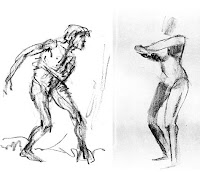
As the evening class gets closer to beginning their creative study the figure, we are beginning to explore the importance and necessity of gesture drawing. Gesture drawing is about the rhythmic movements and energies coursing through a subject rather than simply the subjects parts. It's about seeing and empathizing with the whole dynamic, concentrating on the essential pattern and general form of all the parts rather than the edges, or contours. I know it's hard to break away from those contours, but doing so will open up whole new arena of expression. A gesture drawing tells us what the figure is doing rather that what it looks like. Gesture drawing tells us about the actions, the tensions, and the pulsations that come from a figure's masses and their alignment in space. Gesture drawings are about the spirit rather than the specific. Practice in your journals gesturing folks you observe in the food court waiting in line, in the lobby by the gallery, studying in the lounge upstairs. 30 seconds here, 30 seconds there. Don't worry about what it looks like, but instead feel what it feels like. Practice.











